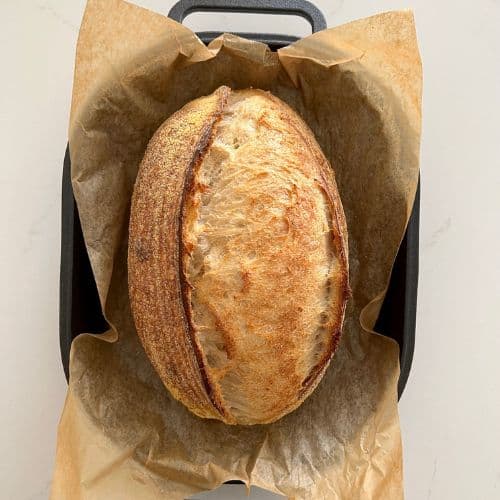Easy Sourdough Batard Recipe
5.0
(1)
Your folders
Your folders
Prep Time: 240 minutes
Cook Time: 45 minutes
Total: 1005 minutes
Servings: 1

Ingredients
Export 2 ingredients for grocery delivery
Instructions
Step 1
Weigh out your sourdough starter and water into a large mixing bowl and mix together briefly.
Step 2
Now add your flour and salt and mix whole lot together to form a dry dough.
Step 3
Cover your bowl with cling film or a damp tea towel and let it sit for around 1 hour. This process is called the "autolyse" and allows your flour to soak in all the water and become hydrated. You can see how the dough has changed in this photo.
Step 4
Bring the dough together into a ball. Pull the edges of the dough into the centre until it's smoother and more formed.You'll notice that the dough is fully hydrated after soaking all the water up. It will be fairly sticky but as you bring it into a ball, it will become smoother and shinier.
Step 5
Once the dough has formed into a smooth ball, pop the cling film back on and let it rest for 30 minutes.
Step 6
Over the next few hours you need to create some structure for your dough by "stretching and folding". Aim to do around 4-6 sets of stretches and folds. For each set, stretch the dough up and over itself 4 times. Leave around 15 minutes in between each set. Again you do not have to be exact with time, but you need to do at least 4 sets over 2 hours.
Step 7
Once you've finished your stretch and folds, place the cling film or damp tea towel back over your dough and let it rest and ferment (a plastic cover is a better option for this stage).
Step 8
Once your dough has finished its first ferment, it's time to shape it so that it will fit into your oval bannton. You'll need to flour your counter top with rice flour for this (we use rice flour because it has no gluten). Try to be quite sparing with the rice flour, you only need a very light dusting. Semolina is also ok for this.Lightly dust your countertop with rice flour (as you get better, you probably won't need any flour at all).Sprinkle a little rice flour into your oval banneton.Use a plastic dough scraper to ease the sourdough out of the bowl and flip it onto the counter top so that the sticky, underneath of the dough ends up on top and the smooth side is on the counter (this will help you manoeuvre your dough much more easily).Use your hands to gently ease the dough out into a rough rectangle, with the short side opposite you.Now, flip the top of the rectangle down.Take the right side of the dough and flip it in and then do the same with the right side. This is creating structure in the dough.Now pick up the bottom of the rectangle and gently roll it upwards, creating surface tension as you come to the top.As you reach the top, gently roll the batard so that the seam is positioned underneath.Now, tighten the surface of the dough by gently putting your hands on the back of the dough and pulling it towards you without taking it off the counter.Now pick up the dough and flip it into the floured banneton with the seam at the top. Use your fingers to bring the base of the dough together to create a tighter seam if you need to.Lift your dough around the edges to pop a little more rice flour if you feel it needs it. Just try to handle the dough as little as possible and be really gentle as you really want to preserve all the gases and air bubbles that have formed during your bulk ferment.
Step 9
Now you need to allow your dough to proof - we generally do this in the fridge. Place an elastic food cover over your dough (shower cap) and place it into the fridge.Try to leave it in the fridge for a minimum 5 hours up to a maximum of around 36 hours. The longer you leave it the better your bread will be! A longer cold ferment creates beautiful blisters on your crust and a deeper sourdough flavour. It will also ensure your dough forms a skin which makes it easier to score.
Step 10
Once you're ready to bake your sourdough, you'll need to preheat your oven to 230C/450F.Place your Oval Dutch Oven into the oven when you turn it on so it gets HOT. Leave your dough in the fridge until the very last minute - placing a cold dough into a hot oven will give you a great "spring".
Step 11
When your oven is at temperature, take your sourdough out of the fridge. Gently place it onto a piece of baking paper.Make sure that you make the baking paper big enough to use the edges as a handle to lower to dough into your Dutch Oven.Gently score your bread with a lame, clean razor blade or knife. At minimum a large cross is sufficient, but you can get as artistic as you like. You can find my full guide on how to score sourdough bread here.Carefully take your dutch oven out of the oven. Place the sourdough into the pot using the baking paper as a handle. Put the lid on and place into the hot oven.If you want to you can spritz your dough with extra water before you put the lid on.BAKE TIME:30 Minutes with the lid on at 230C/450F plus10-15 Minutes with the lid off at 210C/410F
Step 12
When you remove your dough from the oven, carefully remove it from the dutch oven as soon as possible and place on a wire rack to cool.